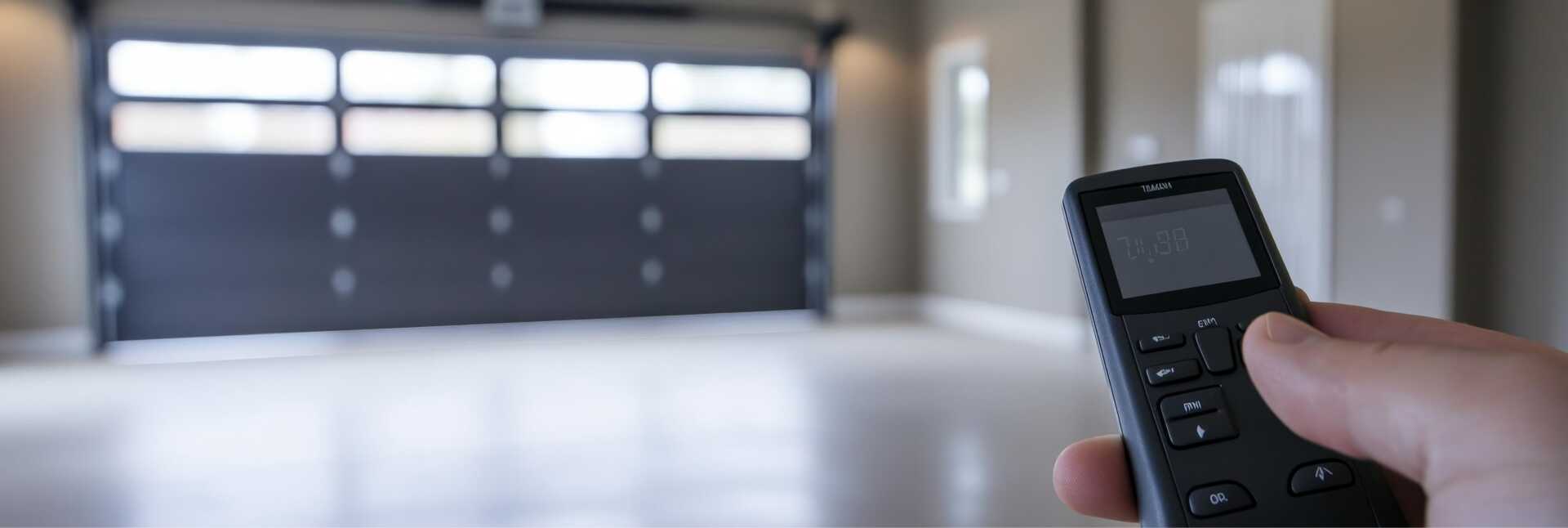
Contents
When replacing a garage door opener, you need to follow a series of straightforward steps to example a smooth process. First, gather your tools and materials, and don’t forget to disconnect the power supply for safety. Then, you’ll need to remove the old opener before installing the new one. Each step has its own nuances, and knowing them can make all the difference in achieving a reliable installation.
Key Takeaways
- Gather necessary tools and materials, including a power drill, screws, and a compatible garage door opener for a smooth installation process.
- Disconnect the power supply by unplugging the opener and turning off the circuit breaker to ensure safety during removal and installation.
- Remove the old garage door opener by detaching it from the ceiling and wall, ensuring to wear safety gear for protection.
- Install the new garage door opener by securing it to the ceiling brackets and connecting the rail and trolley to the garage door.
- Conduct final adjustments and performance checks to ensure smooth operation and verify the functionality of safety features.
Gather the Necessary Tools and Materials
Before diving into the replacement process, you’ll need to gather the necessary tools and materials to ensure a smooth installation.
Start with your tools checklist, which should include a power drill, socket set, screwdrivers, a level, and a measuring tape. Having these on hand will save you time and frustration.
Next, focus on material selection. Choose a garage door opener that fits your garage’s specifications—consider horsepower, type, and features like smart technology.
Make sure to check compatibility with your existing door and any safety features required by local codes. Don’t forget to stock up on screws, brackets, and any other hardware that might be needed for installation.
Disconnect the Power Supply
To safely replace your garage door opener, start by locating the power source.
Unplug the opener to cut off electricity and prevent any accidents during the replacement process.
Always prioritize safety by ensuring the power is disconnected before you begin any work.
Locate the Power Source
Once you’ve gathered your tools, the first step is to locate the power source for your garage door opener. This is essential for effective garage maintenance, especially if you’ve experienced a power outage recently. Start by checking your garage for the outlet where the opener is plugged in.
| Checkpoints | Details |
|---|---|
| Outlet Location | Usually near the ceiling |
| Circuit Breaker | In the main electrical panel |
| Extension Cords | Verify they’re not frayed |
| Power Surge Protectors | Look for any tripped switches |
Unplug the Opener
Start by unplugging the garage door opener from its power source to secure safety while you work. This vital step involves using the correct unplugging technique to ensure effective power management.
Follow these instructions:
- Locate the power cord connected to the opener.
- Firmly grip the plug and pull it straight out from the outlet.
- If your opener has a backup battery, disconnect it as well.
- Double-check that all power sources are completely disconnected before proceeding.
Ensure Safety Precautions
Before you investigate replacing your garage door opener, it’s important to confirm all safety precautions are in place, especially when disconnecting the power supply.
Start by wearing appropriate safety gear, like gloves and goggles, to protect yourself from potential hazards.
Next, locate the garage door opener’s power source and unplug it completely. This step is significant to prevent accidental activation while you work.
Additionally, establish an emergency plan; inform family members of your project and make sure they know not to operate the door during this time.
Remove the Old Garage Door Opener
Before you start, make sure to prioritize safety by wearing gloves and goggles.
Once you’re ready, disconnect the power supply to the opener to avoid any accidents.
Next, remove the mounting hardware securing the opener to the ceiling and wall, which will allow you to take it down safely.
Safety First Precautions
Although removing an old garage door opener may seem straightforward, taking proper safety precautions is essential to prevent accidents and injuries.
Before you begin, ensure you’re equipped with the right safety gear, like gloves and goggles.
Here are some key safety steps to follow:
Inspect the area for any hazards that could cause slips or falls.
Wear appropriate safety gear to protect yourself from potential injuries.
Have a friend nearby to assist you in case of an emergency.
Review emergency procedures beforehand to know what to do if an accident occurs.
Disconnect Power Supply
To safely disconnect the power supply and remove your old garage door opener, start by unplugging the unit from the electrical outlet. This step is essential, especially if there’s been a recent power outage, as it ensures you won’t accidentally activate the opener while working.
Next, take the time to inspect the power cord for any damage; this is a critical safety measure. If you notice any fraying, replace it before proceeding.
After unplugging, it’s wise to turn off the circuit breaker that powers the garage door opener. This adds an extra layer of safety while you work.
Remove Mounting Hardware
Start by removing the mounting hardware that secures your old garage door opener to the ceiling and wall. Understanding different hardware types and mounting techniques is essential for a smooth removal process.
Follow these steps:
Locate screws and bolts: Identify the types of fasteners used in your setup.
Use appropriate tools: Grab a screwdriver or wrench, depending on the hardware type.
Loosen and remove: Carefully unscrew or unbolt the hardware while supporting the opener to prevent it from falling.
Detach from wall/ceiling: Once the hardware is removed, gently pull the opener away from the mounting surface.
With the hardware out, you’re ready to proceed to the next steps!
Install the New Garage Door Opener
Once you’ve removed the old garage door opener, you can begin installing the new unit. Start by positioning the new opener on the ceiling brackets you’ve just cleared. Use the installation tips provided in the manual for correct alignment. Secure it tightly with the mounting hardware.
Next, attach the rail and the trolley, making sure it’s connected to the garage door. Remember to check the opener features, like safety sensors, to confirm they’re compatible with your setup.
Here’s a quick reference table for a clearer picture:
| Step | Action | Tip |
|---|---|---|
| Position the Opener | Align with ceiling brackets | Use a level for precision |
| Secure the Rail | Attach and tighten bolts | Check for smooth operation |
| Connect Trolley | Verify it’s linked to door | Test before finalizing |
Following these steps will set you up for a successful opener installation!
Connect the Wiring and Sensors
Connecting the wiring and sensors is crucial for ensuring your garage door opener functions safely and effectively. Follow these steps to make the necessary wiring connections and achieve proper sensor alignment:
Identify Wires: Locate the correct wires from the opener unit and the power source. Typically, these will include the motor and safety sensor wires.
Connect the Wires: Strip the ends of the wires if needed, then twist them together securely. Use wire nuts to ensure a solid connection.
Install the Sensors: Mount the safety sensors on either side of the garage door, ideally 6 inches above the ground. Verify they’re aligned directly across from each other.
Test Sensor Alignment: Check that the LED lights on the sensors are lit, indicating proper alignment. Adjust if necessary.
Test the Garage Door Opener
Before you can enjoy the convenience of your new garage door opener, it’s essential to test its functionality to ensure everything is working correctly.
Start by verifying the power is connected, and the remote is functioning. Press the opener button and observe how smoothly the door opens and closes. This is your initial test of performance. If the door operates erratically or stops unexpectedly, you may need to adjust the settings or check the sensors.
Next, conduct a safety test by placing a small object in the door’s path. The door should be reversed upon contact to prevent accidents.
Regular garage door maintenance is key to longevity, so keep an eye out for unusual noises or slow response times during testing. If you notice any issues, troubleshoot or consult the manual.
A properly functioning opener enhances convenience and ensures your safety and peace of mind.
Final Adjustments and Safety Checks
As you wrap up the installation of your garage door opener, it’s crucial to make final adjustments and conduct thorough safety checks to ensure peak performance.
Follow these steps to make certain everything runs smoothly:
Adjust the travel limits: Check the opener’s travel settings for both opening and closing. Make necessary tweaks to avoid obstruction.
Test the force settings: Adjust the force needed to open and close the door; it should be sufficient but not excessive to prevent damage.
Inspect the safety sensors: Confirm the sensors are aligned and clean. They should detect objects in the door’s path and reverse operation when necessary.
Conduct a manual release test: Test the manual release mechanism to verify it operates correctly in case of power failure.
Summary
In the end, replacing your garage door opener might seem like an intimidating task, but you’ve just proven that it’s easier than dealing with a faulty opener every day. With the right tools and a little patience, you’ve turned a potential headache into a satisfying DIY project. Ironically, the real struggle isn’t the installation—it’s remembering to close the door once it’s working perfectly. Now, enjoy the convenience of your new opener and keep that door in check!
Recent Posts
Troubleshooting Garage Door Repair: A How-To Guide
You might not realize that regular garage door maintenance can prevent costly repairs down the
3 Tips for Troubleshooting Garage Door Repairs
When your garage door suddenly stops halfway down, it can be frustrating. Start by checking
Why Troubleshooting Garage Door Repairs Matters?
Imagine trying to leave for work, but your garage door won’t budge. This frustrating scenario

